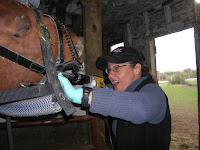Yes, I know this blog is running a little late behind schedule....I do apologize. Hopefully every
 one has been enjoying Lola's twitter updates as well. Well, Lola has had only a few adventures over the last two weeks. We had a few visitors from Fran Minnaert from Purina, Aunt Jodi and Auntie Danyn, to my Uncle Karl and his daughter Lauren, and we even made a new friend, Mrs. Smith! Mrs. Smith was a passerby that had noticed Lola a few different times and admired her as they drove by in her car but on a Sunday afternoon my father and I were out by Lo
one has been enjoying Lola's twitter updates as well. Well, Lola has had only a few adventures over the last two weeks. We had a few visitors from Fran Minnaert from Purina, Aunt Jodi and Auntie Danyn, to my Uncle Karl and his daughter Lauren, and we even made a new friend, Mrs. Smith! Mrs. Smith was a passerby that had noticed Lola a few different times and admired her as they drove by in her car but on a Sunday afternoon my father and I were out by Lo la and Mrs. Smith happened to drive by at just the right time. She stopped and introduced herself and told us how she has loved horses since she was a small child. She petted Lola and talked to her a bit. Before she left Mrs. Smith was very generous and provided us with a donation to help with the care of Lola. Thank you to Mrs. Smith because through her support we were able to purchase another mat for Lola!
la and Mrs. Smith happened to drive by at just the right time. She stopped and introduced herself and told us how she has loved horses since she was a small child. She petted Lola and talked to her a bit. Before she left Mrs. Smith was very generous and provided us with a donation to help with the care of Lola. Thank you to Mrs. Smith because through her support we were able to purchase another mat for Lola!By far the biggest adventure for our foster horse was her visit with the dentist! That's right a dentist for horses! Horse's teeth are unique and require regular examinations by a veterinarian to ensure that there are no abnormalities that could cause abnormal chewing patterns, bit discomfort, excessive wear and premature loss of teeth.
FYI: Horse's have two sections of their teeth, the incisors (in the front) and cheek teeth (in the back). Between these two sections is a large space. The incisors, found in the front of the horse's mouth, are used for grasping and tearing food where as the cheek teeth, the premolars and molars, are responsible for grinding the food. The horse's teeth are constantly erupting out of the gums as they age...this is why many horse people will check the horse's mouth to help determine it's age! Below is a diagram that show how a horse's teeth changes over time (Information Source: "Understanding Your Horse's Teeth" Manuel G. Himens Jr. DVM.

As humans, we usually chew in an up and down fashion but horses are not the same, they chew in a circular motion, which can cause some abnormal wear patterns. Some common abnormalities include: hooks, ramps, waves, and points.
- Hooks: (caudal) "Dominant lower or upper last molar overhanging opposing molar." (rostral) "Dominant upper front premolars overhang lower premolars."


- Ramps: "Excessive height to lower front premolars."

- Wave: "Molar arcade develops an uneven 'wavelike' appearance generally involving many premoloars and molars."

- Points: "Sharp points that generally form on the outside of the upper molars and the inside of the lower molars."

Due to these abnormal wear patterns it is important to have a horse's teeth checked at least annually by a veterinarian and if needed the animal's teeth may need to be floated. Floating a horse's teeth is almost like filing your nails. Most veterinarians today use a powered file to fix abnormalities in the teeth.
On Monday, October 12 Dr. Christine Woodford came to visit Lola and check out her teeth. After inspection we noticed that Lola had a slight wave and some hooks that needed to be fixed.

(Above: Lola's teeth before. Notice the hooks on first premolars on both sides.)


 (The pictures above are of Dr. Woodford floating Lola's teeth.)
(The pictures above are of Dr. Woodford floating Lola's teeth.)
 (The picture on the left is a side by side comparison of the difference between the two premolars. The premolar on the left has not yet been fixed and the premolar on the right has been fixed. Notice the difference! The picture on the left is the final picture when Dr. Woodford finished.)
(The picture on the left is a side by side comparison of the difference between the two premolars. The premolar on the left has not yet been fixed and the premolar on the right has been fixed. Notice the difference! The picture on the left is the final picture when Dr. Woodford finished.)Thanks goes to Dr. Christine Woodford from Veterinary Integrative Performance Services (VIP's) for donating her services to float Lola's teeth.
 www.vipsvet.net
www.vipsvet.net

No comments:
Post a Comment